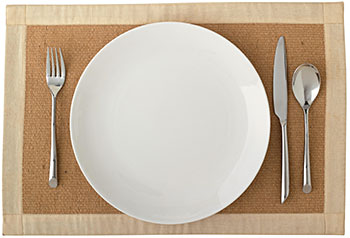More Health and Nutrition Bites
Related
Right-Size Your Recipes
As you might expect, I collect cookbooks. The first cookbook I bought for myself was the Peanuts Cook Book, but the one my mother used most (and I bet yours did too) was The Joy of Cooking. I actually have several copies of this venerable cookbook, from the two-paperback edition from 1974 to the 1946 hardback that my wife bought me for Christmas last year.
What's your personal portion size?
I've spoken and written extensively about portion size and the importance of portion control in weight management. This is partly in response to what is often termed "the super-sizing of America," but it's not just restaurants where portion sizes have blown up in the last several decades.
Dr. Tim Says: Portion Size
In the last few decades it has become a major issue with portions in restaurants increasing dramatically. 40 years ago a 32 ounce milk shake with 1,160 calories would have been unusual. There was no such thing as a Quarter Pounder (let alone a Double Quarter Pounder) and getting a mountain of nachos would be rare. These huge plates have spilled over into how we choose food.
Health & Nutrition Bites
Get the latest health and diet news - along with what you can do about it - sent to your Inbox once a week. Get Dr. Gourmet's Health and Nutrition Bites sent to you via email. Sign up now!
Portion size perception is relative

A couple of months ago I shared with you an article that looked at people's perception of their usual portion size and whether that amount might be larger for those who are considered clinically overweight or obese. Not only did the authors find that those who were overweight tended to have larger personal usual portion sizes than those who were of clinically normal weight, but all of the participants, regardless of their weight status, considered their usual portion size to be larger than the standard portion sizes.
We've seen in other Health & Nutrition Bites that portion sizes have grown in the last several decades - Brian Wansink's assessment of the serving sizes in several editions of The Joy of Cooking is just one of the more interesting. The implication of these and other studies of portion size has been that because people have been exposed to oversized portions so frequently, they are no longer able to correctly assess portion sizes by sight. In short, they're used to larger portion sizes, so they look normal.
Authors in the UK devised a series of studies to see if that might be the case (Appetite 2016;98:28-34). In the first study, carried out online, the researchers used three different pictures of three different serving sizes of spaghetti bolognese, all depicted on white plates that were identical in size and shape. One-third of the participants were first shown a picture of the smallest serving size of spaghetti, one third were first shown a picture of the largest serving size, and the final third were shown a picture of a common household object. All three groups were then shown a picture of an intermediate serving size (what would be considered a standard serving size) of either spaghetti bolognese or another familiar food (chicken curry), and asked whether their "ideal" serving size would be smaller, larger, or the same as that intermediate serving size shown.
In a second, similar study the authors eliminated the household object arm of the study in order to focus solely on the food comparisons. This study used only 55 men and women from the university as well as the surrounding community.
In the final study the authors showed 68 adult female participants photographs of either larger or smaller portion sizes of different brands of crisps (typically these are termed "potato chips" in the United States), then were shown a photograph of a normal size and were asked to evaluate whether a normal serving would be larger, smaller, or the same as the photograph.
After rating the images, the participants were asked to serve themselves a portion of the same food as a snack. How much they chose to serve themselves and how much they actually ate was weighed and compared to a "normal" serving size.
Somewhat unsurprisingly, in the first two studies the participants who were shown smaller servings before evaluating the intermediate serving tended to think that a normal serving was smaller than the intermediate-sized serving. On the other hand, those who were shown the largest serving size tended to think that a normal serving was larger than the intermediate serving size.
In the case of the crisps, however, how people evaluated the intermediate serving size had nothing to do with how much of the crisps they served themselves or how much of them they ate.
What this means for you
The problem I see with the third study is that the participants were evaluating a snack food and not a main course dish. It's quite possible that people's perceptions of what might constitute an appropriate serving size might have little to do with how much they personally would eat. Evaluating spaghetti bolognese would have been a better choice.
The first two studies are much more interesting, suggesting that exposure to various serving sizes might set up a mental norm - and that might affect consumption. Again, if you are working on your weight, you would do well to accustom yourself to standard portion sizes. Here's a guide.
First posted: January 27, 2016
